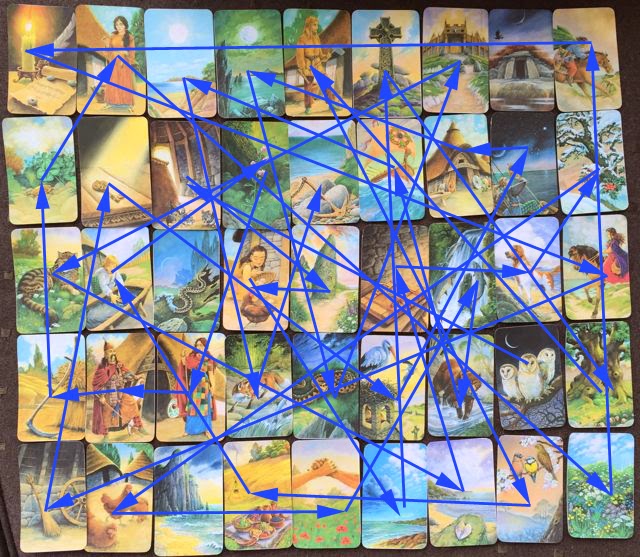Last week, as it was just after Brigid's Day, I looked at how to read a spiritual message for that pagan festival (or any other) from a Grand Tableau thrown with all 45 of the Celtic Lenormand cards.
This week, let's get back to basics. When faced with a Grand Tableau, where to start? And does it make a difference if there are 45 cards, rather than 36?
An oft-used system, especially if there is no specific question for the throw, is to start by reading the theme from the four corner cards, to look at the message of the first three cards, and to take a look at the heart of the throw. The simplest way to do those with this 45 card GT are shown here in blue.
From there, many readers look to the people cards, the Man and Woman or Lord and Lady, to assess what is going on around them, and possibly the relationship between them. Having two people cards can complicate this, as you might ask which you should look to. The two easiest answers are: a) either pick the one that you feel most connected to, or b) look to each for different aspects of your life.
One approach is to see the cards above the "people" cards as representing their thoughts or what they are aware of, and the cards below them as either what they are unaware of, or what they are "on top of", in control of.
Some people seek out particular cards to assess where trouble may lie (cards such as the Snake, Fox, Mountain, Clouds and Cross).
Others look to "signpost" cards such as the Clover for what will happen shortly, the Scythe for what is sudden and unexpected, the Cross for the current life lesson, the Key for what is certain and the Mice for what will be lost/reduced.
Another approach is to look around specific cards representing areas in life of interest, such as the Anchor for work (or whatever you choose as your work card), the Tree for health, and so on.
Like last week's reading, you can read the cards that border the card you are focusing on, as you would with a nine square. You can also look at the diagonals leading to and from it, often considered causes and consequences (yellow arrows show the diagonals around the Man). You can look at the cards that mirror it (green circles for the mirrors to the Lady), and those connected by knighting (red circles from the Man).
Having extra cards in the deck does not affect any of these common techniques for reading a Grand Tableau. However, it will affect how you read Houses, and that will be the subject of next week's post...
This week, let's get back to basics. When faced with a Grand Tableau, where to start? And does it make a difference if there are 45 cards, rather than 36?
An oft-used system, especially if there is no specific question for the throw, is to start by reading the theme from the four corner cards, to look at the message of the first three cards, and to take a look at the heart of the throw. The simplest way to do those with this 45 card GT are shown here in blue.
From there, many readers look to the people cards, the Man and Woman or Lord and Lady, to assess what is going on around them, and possibly the relationship between them. Having two people cards can complicate this, as you might ask which you should look to. The two easiest answers are: a) either pick the one that you feel most connected to, or b) look to each for different aspects of your life.
One approach is to see the cards above the "people" cards as representing their thoughts or what they are aware of, and the cards below them as either what they are unaware of, or what they are "on top of", in control of.
Some people seek out particular cards to assess where trouble may lie (cards such as the Snake, Fox, Mountain, Clouds and Cross).
Others look to "signpost" cards such as the Clover for what will happen shortly, the Scythe for what is sudden and unexpected, the Cross for the current life lesson, the Key for what is certain and the Mice for what will be lost/reduced.
Another approach is to look around specific cards representing areas in life of interest, such as the Anchor for work (or whatever you choose as your work card), the Tree for health, and so on.
Like last week's reading, you can read the cards that border the card you are focusing on, as you would with a nine square. You can also look at the diagonals leading to and from it, often considered causes and consequences (yellow arrows show the diagonals around the Man). You can look at the cards that mirror it (green circles for the mirrors to the Lady), and those connected by knighting (red circles from the Man).
Having extra cards in the deck does not affect any of these common techniques for reading a Grand Tableau. However, it will affect how you read Houses, and that will be the subject of next week's post...












































